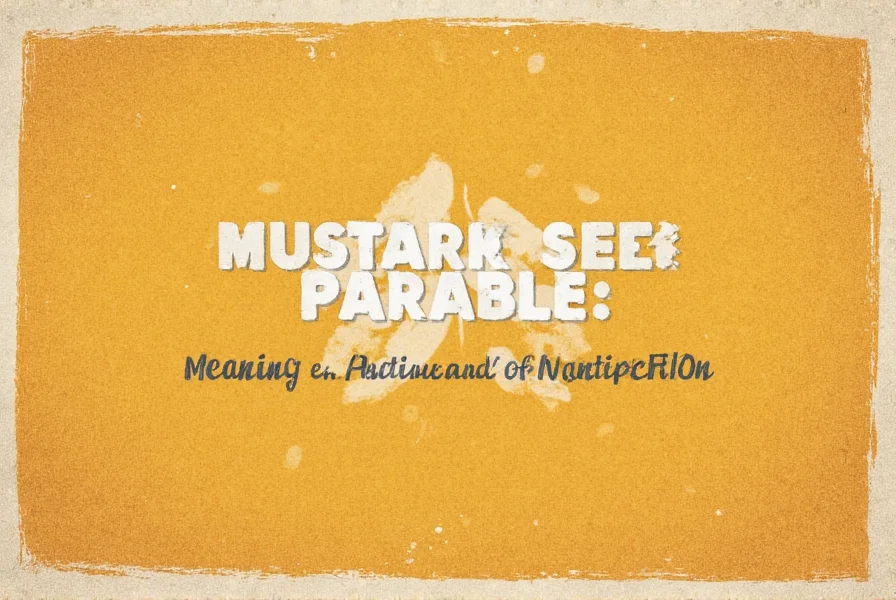The mustard seed parable remains one of the most accessible yet profound teachings in the Gospels. Jesus used everyday agricultural imagery to convey deep spiritual truths about the nature of God's kingdom. Unlike complex theological arguments, this simple story about a tiny seed resonated with farmers and city dwellers alike in first-century Palestine. Understanding the mustard seed parable explanation requires examining both its historical context and enduring spiritual significance.
Biblical Sources of the Mustard Seed Parable
Three Gospel accounts preserve this teaching, each with slight variations that enrich our understanding:
| Gospel | Passage | Key Emphasis |
|---|---|---|
| Matthew | 13:31-32 | Kingdom growth from small beginnings to providing shelter |
| Mark | 4:30-32 | Contrast between tiny seed and large plant |
| Luke | 13:18-19 | Kingdom's unexpected expansion beyond expectations |
These parallel accounts create a more complete picture of Jesus' teaching. The mustard seed parable in the Bible consistently emphasizes the surprising growth pattern of God's kingdom—starting small but becoming substantial. This interpretation of mustard seed parable reveals Jesus' message that divine work often begins humbly but yields remarkable results.
Historical and Agricultural Context
Understanding the mustard seed parable requires knowledge of first-century agriculture. While not literally the smallest seed, the black mustard plant (Brassica nigra) produced seeds about 1-2mm in diameter—among the smallest commonly planted in Palestinian gardens. What made this comparison striking was the plant's potential growth:
- Grows 8-12 feet tall, unlike typical garden plants
- Develops woody stems, functioning more like a tree than a herb
- Provides substantial shade for birds—an unexpected feature for such a small-seeded plant
Jesus' audience would have recognized this plant's invasive nature. Once planted, mustard could quickly dominate a garden. This agricultural reality adds depth to the meaning of the mustard seed parable—God's kingdom, once established, spreads pervasively throughout society.

Interpretation and Theological Significance
The mustard seed parable explanation extends beyond simple growth metaphors. Biblical scholars identify several layers of meaning:
Kingdom Growth Pattern
Unlike earthly kingdoms that begin with military conquest, God's kingdom emerges from humble origins. Jesus himself embodied this principle—born in a stable, raised in Nazareth ("Can anything good come from there?" - John 1:46), executed as a criminal. The mustard seed parable teaches that divine work often appears insignificant at first but eventually transforms communities.
Unexpected Expansion
The parable's reference to birds nesting in the branches echoes Old Testament imagery (Ezekiel 17:23, 31:6; Daniel 4:12, 21-22) where trees represent empires providing shelter. By applying this to the mustard plant—considered a weed by some—Jesus subverts expectations. God's kingdom welcomes all people, including Gentiles (symbolized by birds), contrary to Jewish exclusivist expectations.
Organic Development
Unlike human organizations that require constant maintenance, the kingdom grows organically when planted in receptive hearts. The mustard seed parable application today reminds believers that spiritual growth follows natural patterns—sometimes slow, sometimes explosive—but always according to God's timing.
Common Misinterpretations to Avoid
Several misunderstandings frequently surround the mustard seed parable:
- "Mustard seeds are the smallest seeds" - While not botanically accurate today, in Jesus' context they represented the smallest commonly planted seeds. The point was relative smallness, not scientific precision.
- "The parable is about individual faith" - Though sometimes applied this way (cf. Matthew 17:20), this specific parable focuses on the kingdom's growth, not personal faith size.
- "The large size represents institutional church growth" - Jesus emphasized organic, transformative growth, not organizational expansion.
Practical Application for Modern Believers
The mustard seed parable meaning remains profoundly relevant today. What does the mustard seed parable teach us about contemporary faith?
Patience in Small Beginnings
Many ministries and personal spiritual journeys feel insignificant. The parable encourages persistence when results seem minimal. Like the mustard seed that appears dormant before sprouting, spiritual work often requires time before visible fruit appears.
Embracing Unconventional Growth
God's kingdom frequently advances through unexpected channels—social media ministries, workplace evangelism, artistic expression. The mustard seed parable application today reminds us not to dismiss unconventional methods of kingdom work.
Creating Shelter for Others
The mature mustard plant provided shelter for birds. Similarly, healthy spiritual communities should offer refuge and support to those in need. The parable challenges believers to build communities where outsiders find acceptance and rest.
Comparative Analysis with Related Teachings
The mustard seed parable appears alongside other growth parables, creating a cohesive teaching about God's kingdom:
| Parable | Key Similarities | Distinct Emphasis |
|---|---|---|
| Mustard Seed | Both show small beginnings with large results | Visible, external growth; community impact |
| Leaven (Matthew 13:33) | Both demonstrate kingdom expansion | Internal, transformative influence; hidden work |
| Sower (Matthew 13:3-9) | Both agricultural metaphors | Focus on receptivity of soil (hearts) rather than growth pattern |
This biblical parable of the mustard seed works in concert with these related teachings to present a multifaceted picture of God's kingdom—both visible and invisible, external and internal, immediate and gradual.
Enduring Relevance of a Simple Story
Two thousand years later, the mustard seed parable continues to inspire because it addresses universal human experiences: feeling insignificant, waiting for results, and hoping for meaningful impact. The mustard seed parable jesus told transcends its agricultural context to speak to anyone who has ever wondered if their small contribution matters.
Whether planting literal seeds in a community garden or metaphorical seeds through acts of kindness, the parable encourages us to trust that faithful small beginnings can yield extraordinary results. This timeless teaching remains one of the most accessible entry points for understanding Jesus' vision of God's kingdom—a vision that begins humbly but ultimately transforms the world.
What is the main message of the mustard seed parable?
The main message of the mustard seed parable is that God's kingdom begins in seemingly insignificant ways but grows to provide substantial shelter and blessing for many. It teaches that small acts of faith, when rooted in God, can yield extraordinary spiritual results over time.
Where is the mustard seed parable found in the Bible?
The mustard seed parable appears in three Gospel accounts: Matthew 13:31-32, Mark 4:30-32, and Luke 13:18-19. Each account provides slightly different details while maintaining the core teaching about the Kingdom of God.
Is the mustard seed really the smallest seed?
While not scientifically the smallest seed (orchid seeds are smaller), the black mustard seed was among the smallest commonly planted seeds in first-century Palestine. Jesus used relative smallness familiar to his audience, not making a botanical claim. The point was the dramatic contrast between the tiny seed and the large plant it produced.
How does the mustard seed parable apply to modern life?
The mustard seed parable application today encourages patience with small beginnings, trust in organic growth patterns, and confidence that faithful actions—no matter how small—can yield significant impact. It reminds modern believers that meaningful change often starts humbly but can eventually transform communities and provide shelter for others.
How is the mustard seed parable different from the parable of the leaven?
While both parables illustrate kingdom growth, the mustard seed emphasizes visible, external expansion (a plant growing large enough for birds to nest), while the leaven parable (Matthew 13:33) focuses on internal, transformative influence (yeast working through dough). Together, they present a complete picture of how God's kingdom works—both visibly and invisibly.











 浙公网安备
33010002000092号
浙公网安备
33010002000092号 浙B2-20120091-4
浙B2-20120091-4